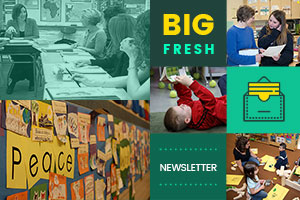Self-confidence is contagious.
—Stephen Richards
Write a Little Poetry
It is April which makes us all think of poetry…At least I hope it makes us all think of poetry. I used to be the kind of person who avoided poetry. It seemed too demanding, wanting me to make sense of words dancing and white space and abstract feelings. I did a fairly good job of avoiding it, even as an English minor. I became a middle school teacher and connected with students over a mutual distaste of poetry.
[Hangs head and wishes for a do-over.]
Then I learned to teach writers instead of teaching writing. The first time I met Ralph Fletcher was in a packed room at NCTE, and he was speaking. I’ll never forget when mid-way through the session, he asked us to write a few lines of poetry, using one of his poems as a mentor text. I looked around and everyone was scratching lines in their notebooks. (This was before we did everything on screens.) Then we were to share with the person beside us.
I turned to an older gentleman, and said, “I’m not a poet.”
His eyes twinkled. He said, “I’m Don,” and he offered his hand to shake. His grip was firm and warm. “Your notebook page looks like it belongs to a poet.” He gestured to the page where I had attempted a few lines of poetry. There were more scratch-outs than words. It was a legit mess. “Will you read me a few lines?”
As I read my scribbled lines about how I didn’t care for poetry, I was glad that he didn’t seem to judge me. Little did I know that Ralph had come up as I was reading my lines out loud.
“Those lines pack a punch,” Don said.
Ralph nodded. “That’s the power of poetry. It’s a small canister to hold whatever we are trying to sort out.”
“You should keep writing,” Don said.
“Definitely,” Ralph said.
The session went on, and I continued to play with the words in my notebook. “Try writing the new version over here,” Don said, pointing to a blank space on my page.
I took his advice. The session ended and I said, “Well, at least it looks like a poem. Thanks for the writing conference, Mr. Graves.”
He chuckled and his attention moved to the many educators who were surrounding him, hoping to share how his work impacted their teaching. I snaked my way to the door.
I found my friends and relayed my experience. “This is the hand that touched the hand of Don Graves,” I said, reminiscent of Pink and Say by Patricia Polacco.” I made sure they each touched my hand so they could go back to their schools and say, “This is the hand that touched the hand that touched the hand of Don Graves.”
Often, I look at my hand, poised over a notebook page, playing with words, and I remember that what I learned in those few short minutes was that I liked to play with words, so it was time to stop hating poetry. My life has never been the same since.
This week we look at helping students take charge of their learning. One way to do this is to join Amy Ludwig VanDerwater at The Poem Farm. She is celebrating National Poetry Month with a new 30-day Poem Farm poetry project. Find out more on the sidebar at her website.
Shine on,
Ruth Ayres
Editor in Chief

Dana Murphy outlines three options to respond to a student who is stuck when reading and looking to the teacher for the answer. By being mindful when students appeal for help, we can make intentional, on-the-spot decisions to empower students to become better readers.
Katherine Sokolowski considers how classroom design says a lot about the relationship between students and teachers.
These days much attention is being given to the science of reading in public discourse and policymaking. It is aimed at instruction for both native speakers and English learners. Timothy Shanahan and Claude Goldenberg weigh in on the messages promoted about the science of reading.
If you’re an instructional coach, we’d love for you to join our FREE coaching network, Coach-to-Coach, led by Ruth Ayres. The next meeting is Wednesday, April 23, at noon EDT.

New members-only content is added each week to the Choice Literacy website. If you’re not yet a member, click here to explore membership options.
Tammy Mulligan knows the most productive and engaging discussions to build reading comprehension are not monopolized by the teacher. She creates a structure to support students to engage in deeper work with each other in small groups. This is the first of a three-part series.
Inspired by Peter Liljedahl’s Building Thinking Classrooms in Mathematics, David Pittman applies instructional practices to get students thinking for themselves as readers and writers, and to be drivers, not consumers or mimickers of someone else’s way of doing things.
Heather Fisher offers four tips for engaging our youngest students with daily criteria for success.
An enthusiastic student response to an author visit inspires Christy Rush Levine to revamp her upcoming unit on craft moves to foster more student ownership.
New members-only content is added each week to the Choice Literacy website. If you’re not yet a member, click here to explore membership options.
Matt Renwick teases out the differences between change and transition. Transitions have a longer timeline than change. Leaders can accelerate this process by building trust, providing clarity, and understanding the process that comes with renewal.
Hannah Tills and Josie Stewart share a way to open data conversations that humanizes the process and encourages everyone to dig deeper to examine each student’s whole story.
Jonathan Winslow offers three practical ways to share teacher learning during a coaching cycle with the entire school or district. His suggestions are excellent ways to uplift teacher voices and inspire one another.
Quote It:
No rain, no flowers.
—Haruki Murakami
That’s all for this week!



